Restoration of Bristol Type 192 Belvedere HC1 (nose Section), XG462
Belvedere XG462 History |
||||
 |
||||
|
Bristol Belvedere HC.1, XG462, c/n 13357, was built in Weston-super-Mare,
as the 10th production machine, and was delivered to No.66 Squadron,
at RAF Odiham, in September 1961, becoming 'H'. XG462, seriously affected by the engine fire, was written-off but the almost undamaged forward fuselage section was retained and held as a spare at Weston-super-Mare and later at Henlow, until the RAF replaced their Belvederes with the Wessex, in 1969. After many years of storage, by the RAF Museum, it was acquired by The Helicopter Museum, in September 1989, and shipped back to Weston-super-Mare.
This nose section of The Museum's second Belvedere was moved into the Restoration
Hangar on 23rd November 2002. It occupied the space vacated when the
restored Kamov Ka-26, DDR-SPY was moved out, for public display, on 18th September 2002. |
||||
Belvedere XG462 Restoration |
||||
| Before work began on the fuselage (near right), in 2002, it was evident that the forward cockpit glazing was in good condition, with no crazing, though very dirty and covered in wax. Behind the flight cabin the engine bay (far right) needed thorough cleaning. This is the area which housed one of the two Napier Gazelle Mk.100 turboshaft engines. |  |
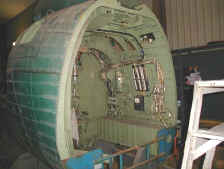 |
||
| The cockpit interior (near
right), seen before restoration and
refurbishment.
By July 2003 most of the control linkages had been cleaned up and repainted. Most of the area beneath the cockpit floor had been completed (far right) while work on the interior continued. |
 |
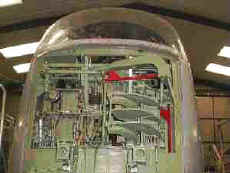 |
||
| By mid-2003 much of the old exterior
paint had been removed, the perspex glazing panels were cleaned, work had started on
various switch panels, some control rods and couplings were dismantled for refurbishment
and many of the fittings prepared for painting.
On 19th April 2003 the entire nose section had been lifted from its cradle and turned so as to rest on its rear end (right), allowing work to proceed on the bottom of the fuselage which had been inaccessible. |
||||
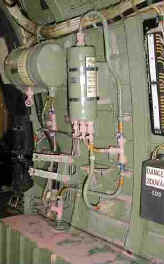 |
Some of the components of the iso-propyl-nitrate (Avpin) starting system, for the Gazelle engine, are visible (left) in the engine bay. The forward engine was mounted here, with its centre line tilted slightly forward of the vertical, secured by three struts which were bolted to two mounting pads on the engine and to three lugs on the aircraft structure. A bulge in the port side of the bay (right) allowed a crew member to squeeze past the engine, from the cockpit into the main cabin. The rear engine was located beneath the fin, in a similar manner, but with the centre line tilted slightly rearwards from the vertical. |
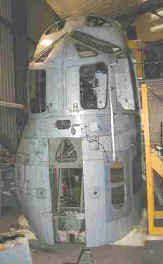 |
||
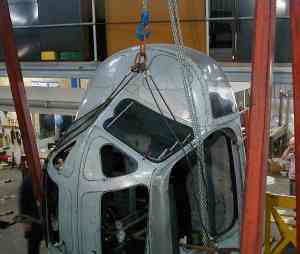 |
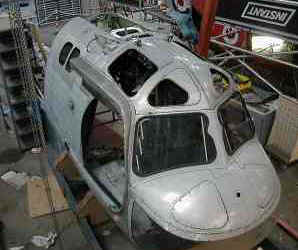 |
|
| On June 30th 2004 XG462's nose section was raised from the floor (above left) and tipped through 90 degrees to become horizontal again. It was then lowered onto a new wheeled cradle (above right), which had been re-constructed on site. | ||
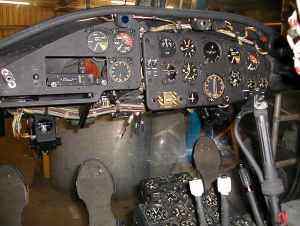 |
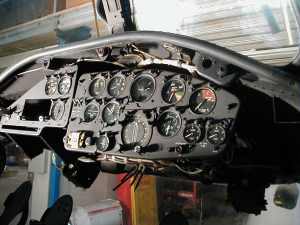 |
|
| The refurbishment of Belvedere XG462's instrument panels was nearing completion and work on the cockpit fittings continued in October 2004. The Navigator/2nd Pilot's panel (above left) carries a duplicated rotor RPM gauge and torquemeter, with the radio compass/ADF indicator below them. The horizontal slot, in the bottom left of this panel, housed the navigator's pull-out chart board. | ||
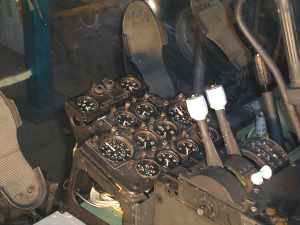 |
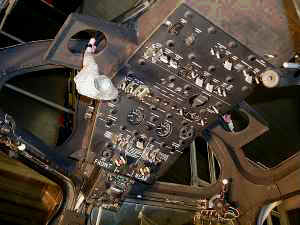 |
|
| Belvedere XG462's central floor console. | Belvedere XG462's overhead console | |
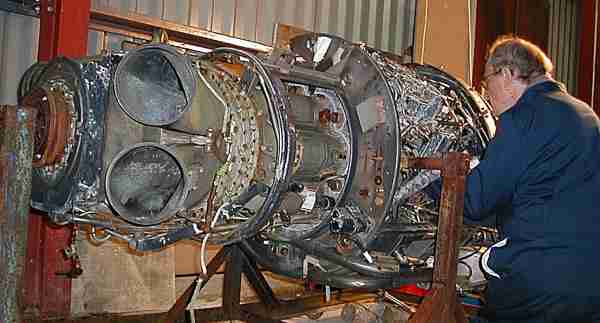 |
||
| In December 2004, Peter, The Museum's new volunteer engine expert, commenced the long job of restoring one of the Napier Gazelle Mk.100 turboshaft engines to a condition which will make it suitable for installation and display in XG462's nose section. Having spent many years in the open air, only partially shielded by a tarpaulin, it was not surprising that the engine's main problem was corrosion. Much of the Gazelle would have to be dismantled, so Peter's first task was to identify, label and photograph all the ancillary pipes, valves and connectors. Work was halted a year later but was eventually taken on by the Rolls-Royce Heritage Trust in Bristol. On completion of refurbishment the engine was shipped back to The Museum, in January 2012, and put on display adjacent to the XG462 nose section. | ||
 |
| In May 2005 the starboard sliding door, with jettison handles, was fitted to XG462. |
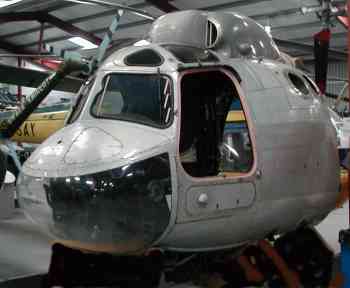 |
| XG462's nose section was moved to the Main Display Hangar on 15th October 2005, with the first stage of restoration completed. |